We stood quietly on the edge of a dark field, listening for owls. A pair of killdeer anxiously called, but we did not hear any owls, so we waited. It was 6:30 in the morning and we were beginning to count all the birds we saw on four tracts of preserved Katy Prairie. There were six of us, and we were teachers, professors, engineers, and oil executives. Some of us were old friends, and some had never met before. But for the day we were a team, and were going to do our best to identify and count every bird on the land and in the sky over our assigned piece of this planet. We were only one of several groups headed out over the threatened Katy prairies.
This was the 111th Christmas Bird Count in North America, and it involved thousands of people, focusing on their 15-mile diameter circles, breaking up into teams, and giving their counts to their compiler, in our case the amazing Fred Collins, now director of Kleb Woods Nature Preserve. Our count is called the Cypress Creek – Katy Prairie (TXCY) and there are lots of other counts in Texas listed at the Houston Audubon site. Our count is always on New Year’s day, so you won’t find me out partying too late the night before. The counts can run from 14 December to 5 January, and my goal is to do more counts in future, maybe including some in Mexico, and of course St. Louis.
Why? What’s so great about spending the entire day outside, often in the company of strangers, walking over rough ground staring at flocks of thousands of blackbirds, with only the occasional rare gem? For me, it is one of the few times I can take the measure of a day, from the sun’s first glimmer, and the morning clouds, through the blazingly clear sky of midday, through the afternoon winds to evening stillness. This happens every day, of course, but mostly we aren’t paying attention. But if you walk the land you do.
Who else is here, sharing our planet? At this time of year, birds and plants are most easily observed, and so, for our fields, we learned exactly who depended on this land. We did hear an owl, a great-horned owl, at least two. We saw a kestrel fast-winged hovering over a possible mouse. We saw harriers swooping, mostly low, buzzing the grasses, then tilting up. Higher were red-tailed hawks. We saw no caracaras this year, but remembered the pair we saw last year near Live Oak creek. The Katy Prairie Conservancy sold that property, but with a conservation easement. There is so much money in Houston, and so little shared with this vital group. Houston has no green belts, and funding for nature is tight. Houstonians are so friendly and seemingly generous, it just doesn’t add up.
My heart still pounds when I hear geese, and look up to see their lines crossing overhead, sometimes in V shapes, sometimes merging and splitting. They’re here for the winter, and they eat the remains in rice fields and prairies. What do they do when their landscape changes under them? Fred Collins could move the 15 mile circle that we count a little farther west when development paved over a large swath of the circle, but what do the birds do?
Our best bird? An orangey Le Conte’s sparrow, huddled at the base of a dead plant, only 10 feet away. It hopped after about 3 minutes, but only another foot or two forwards. It straddled the plant, each foot on a separate dead stem. I wondered how many we missed. Mostly what we saw were thousands of savannah sparrows.
We do our best at counting and seeing, but at no time are we more aware of the limitations of our method. What did we miss? Did we already see that bird? How many are in that flock? Audubon has rules to systematize counting, like you can’t count birds you see when you retrace your steps, unless they are a new species. We know how to estimate numbers in a flock (count a small area, then judge how many areas of that size there are), and sometimes can just photograph the flock, and take a count of the birds in the photograph. Rare birds have to be documented in various ways.
Inaccuracy, and error is a part of any scientific study. What is important is that we understand the nature and scope of the error. We most hope that there is no systematic bias in the error. Error that is noise obscures the true answer, but it is still most likely to be in the middle of the distribution. Christmas count error is mostly of the form of noise, not systematic bias. These data are invaluable for getting comprehensive long-term patterns, such as are needed for understanding global warming, and the bird’s response. In science we depend on sampling, on understanding the strengths and weaknesses of our system, and these are well-known for Christmas bird counts. The Cornell University Lab of Ornithology is a scientific place for citizen science projects like the CBC, and there are also lists of publications based on the counts at the main Christmas Bird Count site.
I’m glad there is scientific merit to the Christmas Bird Count, but there is also personal enrichment. What better way could there be to welcome the new year than walking our land from dawn to dusk, taking the measure of a day?
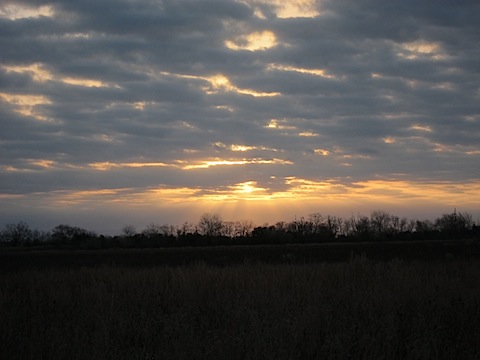
Dawn over Hebert Reservoir on the Katy Prairie.
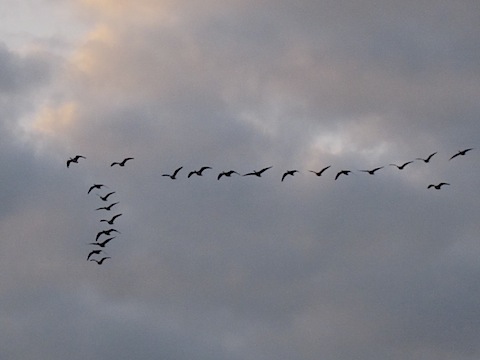
We saw thousands of snow geese, and many Canada geese, and long-billed curlews.
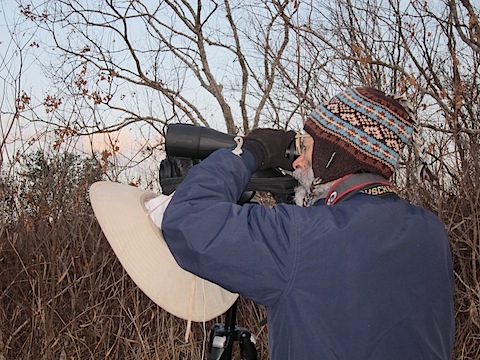
Our group counted every bird we saw, writing down species, number, and location using our eyes, binoculars, and a spotting scope.
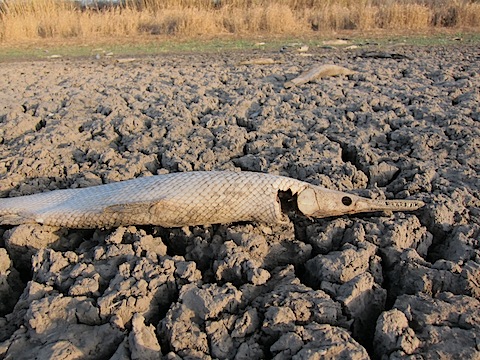
The reservoir was dry, so all the gar had died.
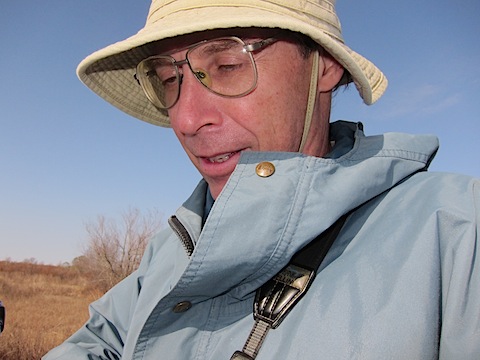
Bob Honig was our leader, and he wrote everything down and could identify all the birds.
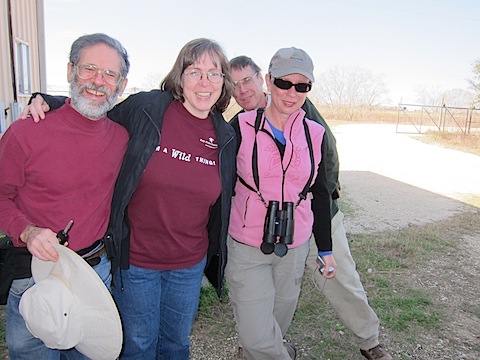
Our group was a lot of fun!
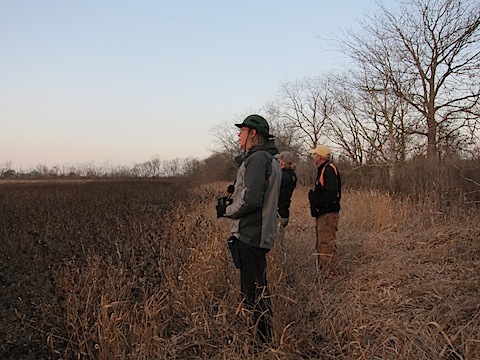
Sometimes we just waited, looking hard, particularly after the wind picked up, sending the birds to cover.
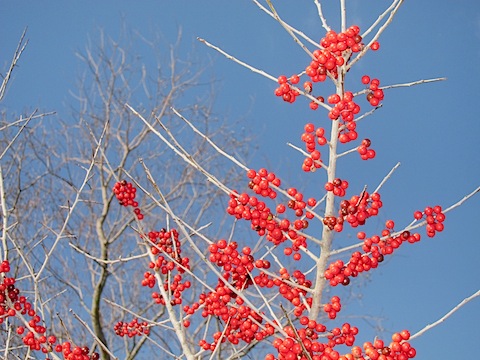
Deciduous yaupon is not common in Houston, but it shines brilliantly on the Katy Prairie.

This is what Bob’s notes looked like, a page for each location.
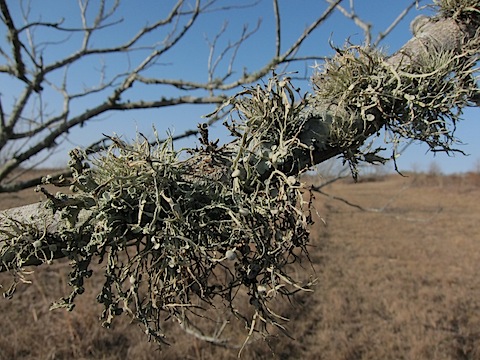
The lichens were rich in the unpolluted Katy Prairie air.

Something was killing the turtles in the pond and something was dragging them onto the levee. Were these the same things?
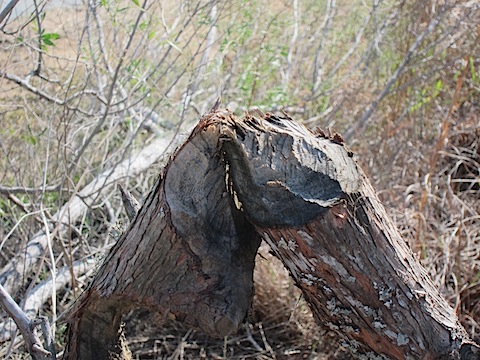
We didn’t see the beavers, but they are around!

We saw cedar waxwings, a kingfisher, and golden-crowned kinglets at Live Oak Creek. Birds need water.
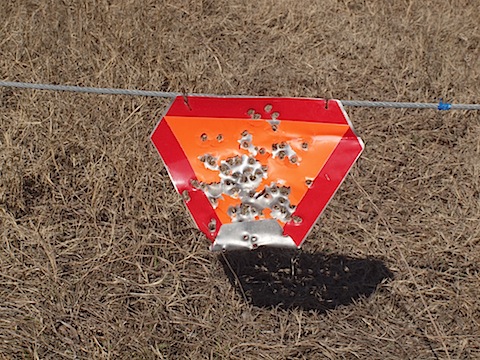
This one sign can stand in for all the harm humans do to the prairie. Rogue ATVers are a problem, homes and malls worse.
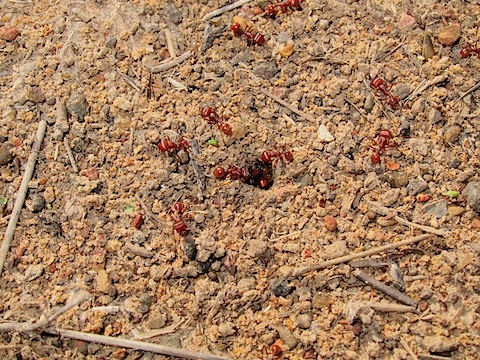
By mid morning the harvester ants (Pogonomyrmex barbatus) slowly emerged. We saw two colonies.

Shrikes cannot hold their prey and so impale them on thorns, twigs, whatever they can find!

This cricket was on the barbed wire spike right next to the grasshopper.

Our prairie needs so much help to keep its subtle wonders from developers. Please donate to the Katy Prairie Conservancy. Every year preserving the land gets more expensive.
